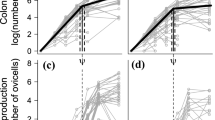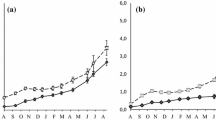Abstract.
Compensatory growth is widespread in juvenile animals; it refers to the ability to grow at faster-than-routine rates, following intervals of slow growth due to reduced food supply or temperature. Whether the ability to grow rapidly under routine conditions is associated with enhanced or reduced compensatory growth performance is unknown. We examine the among-population covariance in routine and compensatory growth ability in juvenile Atlantic silverside, Menidia menidia. Routine growth rate in this species positively varies with latitude, indicating selection for more rapid increase in size in highly seasonal environments. High-latitude fish may also show strong compensatory ability, considering the selective value of rapid recovery from winter for growth and breeding in the spring. Alternatively, low-latitude fish may be more readily able to compensate because they have more energetic scope for growth. To test these alternatives, laboratory-reared juveniles from three populations [Nova Scotia (NS), New York (NY), and South Carolina (SC)] were maintained at temperatures promoting maximum growth. In each population, control fish were furnished ad libitum rations, while treatment fish were subject to 5 or 10 days of maintenance ration before returning to unlimited ration. Treatment fish grew slightly in length, but not mass, over the period of limited ration. We observed compensatory growth in all populations. NS fish recovering from 10 days of limited ration grew 12% faster in length and 46% faster in dry mass than NS control fish, over 15 days of unrestricted growth. In contrast, recovering SC fish grew 1.4% faster in length and 22% faster in dry mass than SC control fish. A period of starvation (mass loss) is not a required condition for a compensatory response, as has been assumed in theoretical work. The positive covariance between routine and compensatory growth performance indicates that the growth rate strategy of high latitude fish includes rapid recovery from periods of depletion, adding to the suite of characteristics that have differentiated along an environmental gradient in seasonality.
Similar content being viewed by others
Author information
Authors and Affiliations
Corresponding author
Additional information
Electronic Publication
Rights and permissions
About this article
Cite this article
Schultz, E.T., Lankford, T.E. & Conover, D.O. The covariance of routine and compensatory juvenile growth rates over a seasonality gradient in a coastal fish. Oecologia 133, 501–509 (2002). https://doi.org/10.1007/s00442-002-1076-4
Received:
Accepted:
Published:
Issue Date:
DOI: https://doi.org/10.1007/s00442-002-1076-4




